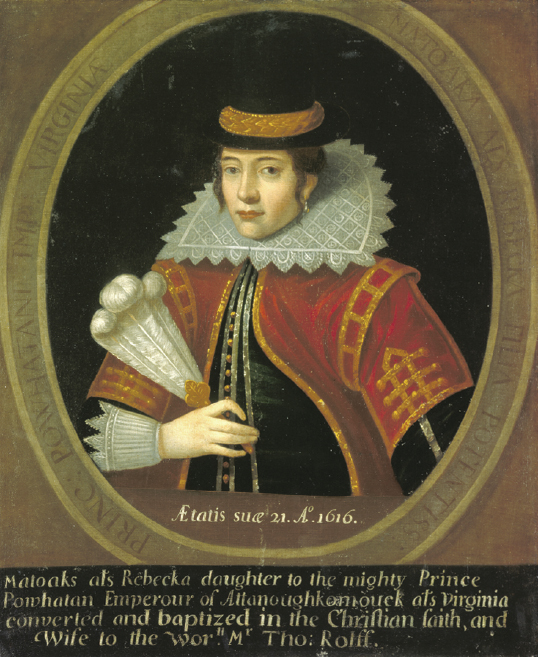Cooperation and Conflict between Natives and Newcomers
Printed Page 58
Powhatan’s people stayed in contact with the English settlers but maintained their distance. The Virginia Company boasted that the settlers bought from the Indians “the pearles of earth [corn] and [sold] to them the pearles of heaven [Christianity].” In fact, few Indians converted to Christianity, and the English devoted scant effort to proselytizing. Marriage between Indian women and English men also was rare, despite the acute shortage of English women in Virginia in the early years. Few settlers bothered to learn the Indians’ language.
The miscommunication and misunderstandings between the settlers and Powhatan’s people are illustrated by the story of the capture and release of Captain John Smith. In December 1607, Smith was captured by warriors of Powhatan. According to Smith, Powhatan “feasted him after their best barbarous manner.” Then, Smith recalled, “two great stones were brought before Powhatan: then as many [Indians] as could layd hands on [Smith], dragged him to [the stones], and thereon laid his head, and being ready with their clubs, to beate out his braines.” At that moment, Pocahontas, Powhatan’s eleven-year-old daughter, rushed forward and “got [Smith’s] head in her armes, and laid her owne upon his to save him from death.” Pocahontas, Smith wrote, “hazarded the beating out of her owne braines to save mine, and … so prevailed with her father, that I was safely conducted [back] to James towne.”
Historians believe that this episode happened more or less as Smith described it. But Smith did not understand why Pocahontas acted as she did. Most likely, what Smith interpreted as Pocahontas’s saving him from certain death was instead a ritual enacting Powhatan’s willingness to incorporate Smith and the white strangers at Jamestown into Powhatan’s empire. By appearing to save Smith, Pocahontas was probably acting out Smith’s new status as an adopted member of Powhatan’s extended family.

CHAPTER LOCATOR
What challenges faced early Chesapeake colonists?
How did Chesapeake tobacco society take shape?
Why did Chesapeake colonial society change in the late seventeenth century?
Why did the southern colonies move toward a slave labor system?
Conclusion: Why were export crops and slave labor important in the growth of the southern colonies?
 LearningCurve
LearningCurve
Check what you know.
After Smith returned to England about two years later, relations between Powhatan and the English colonists deteriorated into bloody raids. In 1613, the colonists captured Pocahontas and held her hostage at Jamestown. Within a year, she converted to Christianity and married a colonist named John Rolfe. After giving birth to a son named Thomas, Pocahontas, her husband, and the new baby sailed for England in the spring of 1616. There, promoters of the Virginia colony dressed her as a proper Englishwoman and arranged for her to go to a ball attended by the king and queen. Pocahontas died in England in 1617. Her son, Thomas, ultimately returned to Virginia.
Events like the capture of Pocahontas gave Powhatan’s people good reason to regard the English with suspicion. Although the settlers often made friendly overtures to the Indians, they did not hesitate to use their guns and swords to enforce English notions of proper Indian behavior. When Indians refused to trade their corn to the settlers, the English pillaged their villages and confiscated their corn.
The Indians retaliated against English violence, but for fifteen years they did not organize an all-out assault on the European intruders, probably for several reasons. Although Christianity held few attractions for the Indians, the power of the settlers’ God impressed them. One chief told John Smith that “he did believe that our [English] God as much exceeded theirs as our guns did their bows and arrows.” Powhatan probably concluded that these powerful strangers would make better allies than enemies.
The English also traded with his people, usually exchanging European goods for corn. Native Virginians quickly recognized the superiority of the intruders’ iron and steel knives, axes, and pots, and they eagerly traded corn for them.
But why were the settlers unable to feed themselves for more than a decade? First, as the staggering death rate suggests, many settlers were too sick to be productive. Second, very few farmers came to Virginia in the early years. Instead, most of the newcomers were gentlemen and their servants who, in John Smith’s words, “never did know what a day’s work was.” Smith declared repeatedly that in Virginia “there is no country to pillage [as in New Spain]. … All you can expect from [Virginia] must be by labor.”
The persistence of the Virginia colony created difficulties for Powhatan’s chiefdom. Steady contact between natives and newcomers spread European diseases among the Indians, who suffered deadly epidemics. To produce enough corn for trade with the English required the Indian women to spend more time and effort growing crops. But from the Indians’ viewpoint, the most important fact about the always-hungry English colonists was that they were not going away.
Powhatan died in 1618, and his brother Opechancanough replaced him as supreme chief. In 1622, Opechancanough organized an all-out assault on the English settlers. As an English colonist observed, “the savages … fell upon us murdering and killing everybody they could reach[,] sparing neither women nor children.” In all, the Indians killed 347 colonists, nearly a third of the English population. But the attack failed to dislodge the colonists. Instead, in the years to come the settlers unleashed a murderous campaign of Indian extermination that pushed the Indians beyond the small circumference of white settlement. After 1622, most colonists considered Indians their perpetual enemies.